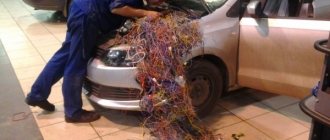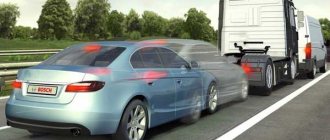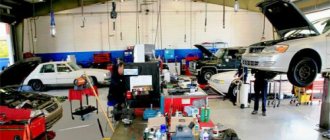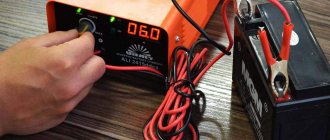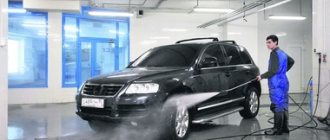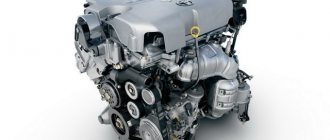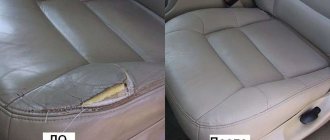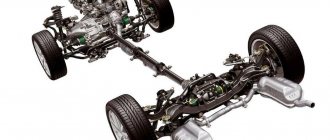1 improved engine performance 2 reduced vehicle weight 3 Improved wheel friction improved traction of the vehicle with the road surface 4 Air resistance and speed Improved aerodynamic properties of the vehicle 5 Power loss in the transmission Reduced inevitable loss of power when passing through the transmission 6 Improved starting properties through the use of electronics 7 Reducing system inertia
In this article we will look at reducing and redistributing the weight of the car to obtain better performance in acceleration to 100 or more.
1. If the weight is reduced by 10%, the acceleration time to 100 will also decrease by about 10%. For example: we have a car with a mass of 1000 kg, an engine of 100 hp and an acceleration to 100 of 12 seconds, if we manage to lighten this car to 900 kg then Acceleration to 100 km/h will be reduced to 10.8 seconds. 2. Such a linear relationship only works in airless space. But in fact, the car does not improve its acceleration characteristics after 130-250 (depending on engine power) due to the presence of aerodynamic air resistance, even if we greatly reduce the weight of our car.
Example 1: a car weighs 1000 kg, 100 hp, acceleration to 100 in 12 seconds, acceleration to 160 will take 29 seconds. Reduce the mass to 900 kg, 100 hp, acceleration to 100 will become 10.8 and decrease by 10%, but acceleration to 160 km/h will be 28 seconds. and decrease by only 3.5% since at speeds from 130 to 160 the engine has to give half of its power to overcome air resistance (50 hp) and the car accelerates not all 100 hp but the remaining 50 hp.
Example 2: With the same parameters we have a car with a more powerful engine of 250 hp for example. Here, the threshold for a conditionally linear improvement in acceleration due to weight reduction will extend beyond 160 km/h for the simple reason that upon reaching a speed of 130 km/h, an engine with a net power of 250 hp will also use 50 hp to overcome air resistance, but he still has 200 horses left to continue accelerating.
3. During intense acceleration, the rear axle of the car is loaded and part of the mass from the front is redistributed back, which is good for rear-wheel drive cars and bad for front-wheel drive cars, since on rear-wheel drive cars the grip on the road improves, and on front-wheel drive cars it decreases, interfering with a slip-free start. On all-wheel drive vehicles, the redistribution does not particularly affect them because they use the entire mass of the vehicle and start with virtually no slipping on all wheels.
On powerful cars, the issue of excessive slippage is especially important, hence some useful tips for reducing the weight of the car in accordance with the available front, rear or all-wheel drive.
On front-wheel drive, if you want to achieve good acceleration and not have problems with starting, you should not greatly reduce the weight of the front part of the car and divide the main emphasis on lightening on the middle and rear part of the car. Also, for better loading of the front axle, you can move some units (if possible) as close as possible to the front bumper. Some even transfer the engine, not to mention the battery, radiator, washer tank, etc. You can also tilt the front of the car down, which will redistribute the weight closer to the front of the car.
On a rear-wheel drive car, you should not lighten the rear part, but focus on lightening the middle and front part of the car, plus you can move some components from the hood to the trunk (battery, washer reservoir, etc., which is possible). If the tank is in the middle, it can also be moved to the trunk (usually a non-standard one is installed tank)
With all-wheel drive, you can lighten anything and everything without fear of a bad hook.
Carburetor tuning
How is carburetor tuning done? First you need to throw out the spring located in the drive, in the throttle valve. This can be done in 5 minutes. Only beginners will spend more time, and even then, searching for this spring. As a result, the owner of a carburetor miracle will receive more sensitive and improved dynamics, while fuel consumption will be no more than half a liter per 100 km.
Throttle Actuator
It is also possible to remake the drive in the throttle valve, which is located in the secondary mechanical vacuum chamber. Using wire, you need to make a ring on one side, and then push this ring under the nut. The nut is attached to the damper drive levers (the protrusion to the outer levers is visible) so that the wire is between the parts. After this you need to shake the nut thoroughly. This improvement will be felt when cornering at high speeds, but there will be no excessive fuel consumption.
Options for adding power
Reducing the weight of the car
To do this, heavy parts are replaced with analogues made of light but very durable material. This method allows you to reduce fuel consumption, improve handling, and increase dynamics. But to the question whether it is possible to improve engine functions thanks to it, the answer is unequivocal - no.
Install a filter with zero resistance
The simplest and most inexpensive method applied to sports cars. The filter has maximum cleaning power and does not resist the passage of air. This speeds up its access to the combustion chamber, facilitating efficient use of gasoline and a significant increase in engine power.
Thanks to the ability to clean, the filter does not need to be replaced, which allows you to significantly save your budget. True, this method does not allow achieving a significant increase in power.
Cylinder boring
This is a truly effective option that requires minimal investment. It consists of increasing the volume of the cylinders of the block by boring. Due to this, connecting rods and pistons undergo changes.
This technique does not guarantee that the increase in power will meet the expected result. It is possible that with minor changes, fuel consumption will increase quite impressively.
We install sports analogues to standard parts
Thanks to forged pistons, it is possible to significantly increase the loads placed on the engine. Such an increase in engine power makes it possible to achieve the expected results, squeezing the maximum out of any unit.
But, in this case, you will have to replace the brakes and gearbox (gearbox), which need to be adapted to new loads. The advantages of this technique include maintaining fuel consumption within the same limits, as well as increasing the operating period due to the use of high-quality parts.
Reprogramming the ECU (electronic control unit)
Almost all cars with injection engines are equipped with a control unit with a specific operating program. Despite a number of restrictions imposed by the ECU on specific engine characteristics, they can be successfully circumvented.
Programmers have their own way of doing this, allowing them to introduce new parameters into the car’s “brain”. Thanks to computer technology, such chip tuning gives effective results.
Carrying out such a procedure on your own is not recommended. This can lead to a program failure that can damage the unit. This work should be done by professional programmers!
Replacing the exhaust pipe with a straight-through one
If you are interested in how you can increase engine power, you should pay tribute to this not entirely standard technique. It can add about 15% to the maximum power at insignificant costs; it consists of installing a direct-flow pipe to the exhaust system.
Reducing the weight of the car
For greater dynamics, you can try to lighten the car by simply removing unnecessary junk from it. This usually includes a spare battery, heavy tools, bottled water to stock up on just in case, and even a spare tire. Sometimes all this can weigh up to 100 kg.
Alloy wheels and other lightweight parts
Various ways have also been invented to improve dynamic characteristics through suspension parameters that reduce the weight of the car. This will also improve the safety of the machine. Light alloy wheels also help reduce weight. Thanks to the disks, the car can be “lightened” by 20 kg! Sometimes car owners resort to replacing parts with analog, lighter ones. For example, this is replacing the hood and trunk lid with carbon ones, or installing lighter seats for passengers.
Is a body that is objectively too durable needed?
Yes, unfortunately, the body of a modern car has become a vulnerable place for dents and corrosion. And even more unfortunately, a thin body has ceased to be a distinctive feature of cheap Chinese cars. Now even quite respected European and American automakers cannot boast of high quality bodywork, the repair or restoration of which is required after a couple of years even of careful use. Therefore, you should not expect that things will be “as before.” But new cars have a lot of advantages that more than compensate for their shortcomings. The safety of cars has become much higher, as well as maneuverability, aerodynamics, functionality, ease of operation, weight and fuel consumption have decreased. And, you see, these advantages justify the need to visit the tinsmith once again. In addition, manufacturers are actively working on the problem of the vulnerability of thin bodies, actively introducing new materials, including aluminum and polymer composites.
So, after weighing all the pros and cons, we can come to an objective conclusion. The laws of physics are inexorable for everyone. A heavy body made of thick metal becomes an obstacle to improving the performance of the car. Also, a body with an excessive margin of safety leads to excessive consumption of resources, and the car will become morally, functionally and aesthetically obsolete much earlier than it uses up its durability resource.
Increasing engine power
In general, engine power is often increased to improve vehicle dynamics. There are several methods available. One of them is the simplest: buy a special device at the car market to increase engine power. It is capable of increasing up to 15%. The device can be easily installed under the hood and remains invisible when diagnosing a car. The essence of the device is to speed up the injection control process by an order of magnitude. The device uses the entire standard engine resource provided by the manufacturer, but its use may lead to a decrease in the durability of the motor.
Chip tuning
Chip tuning leads to an increase in engine power. However, despite all the effectiveness of the method, it can lead to misunderstandings in the event of warranty repairs. The engine power is also increased with the help of a device that supplies nitrous oxide. Another option is to replace the muffler. The power of the motor depends on the difference in pressure inside and outside the motor. If the muffler is removed from the car, then under normal weather and temperature conditions the engine power will increase by up to 30%. Only according to current legislation, the sound of the exhaust, unfortunately, does not allow driving a car without a muffler. Some car owners still find compromises by installing an intermediate version of the muffler that produces less noise and more power.
Increased motor power
Re-equipping the power unit helps improve acceleration dynamics. This includes not only engine tuning, but also replacing the muffler, installing a turbine and much more.
Chip tuning
In fact, all devices for increasing engine power only release the potential built into the power unit by the manufacturer. For example, engine chip tuning. Today there are two options for increasing power:
- flashing the ECU with installation of a new program;
- installing the module directly on the power unit.
German accessory manufacturers (for example, RaceChip) promise up to a 30% increase in engine power.
In this case, you can install the module yourself. Manufacturers offer an accessible connection diagram that is easy to understand even for an inexperienced driver. But it is better to reinstall the electronic program under the supervision of a specialist.
The operating principle of both the module and the chip is similar. The equipment measures engine operating parameters in real time - frequency and quantity of injection, and transmits information to the on-board computer two to three times faster and more often than standard sensors. Adjustment of fuel system parameters is accelerated, and the frequency of injection into the cylinders increases. Accordingly, engine power increases.
Efficient suspension
Increasing the efficiency of machine power transfer from the engine is possible by consuming energy only in the target direction. In a car with an excessively soft suspension, during a sharp start, almost all the energy is transferred to the suspension, and the car sags. That is, engine power is spent mainly to compress the springs and suspension springs, and not to move forward. To avoid wastage of energy, the suspension should be made more rigid by changing the springs and adding springs. To remove excess vibrations, it is necessary to strengthen and harden the body by adding stiffeners. To provide additional driving dynamics, tire pressure is increased. At low pressure, most of the energy begins to be spent on overcoming the friction force with the surface of the road surface, and at high pressure, the friction force decreases. But if the wheels are overinflated, there is a risk of a single blowout; the wheel can explode, which can lead to tragedy on the road. Some car owners are replacing standard brakes with more powerful ones.
In general, the implementation of all the above recommendations and the implementation of a number of technical measures of varying complexity can increase the dynamics of the car on the road by up to 50%, and the acceleration speed by 30%.
How to improve your car
No matter how you choose a car as your life partner, you can’t just isolate yourself from the annoying and “dirty” noise. This completely contradicts the idea of the cabin, which should be a personal and perfectly comfortable space for the driver and his passengers. But why does the opposite happen and what to do about it?
Cars for cars' sake.
A car has long ceased to be just a means of transportation. Now it is a lifestyle, a second home, an integral part of existence. The salon, in addition to its basic functionality, must correspond to the person’s personality and needs. And one of these needs is definitely driving pleasure.
By the way, car factories always pay attention to introducing innovations into the basic characteristics of the car, often forgetting about the interior and its contents, and in terms of noise level they strive to comply only with state standards, which today can hardly meet the requirements of car owners.
And this is precisely what makes up the lion’s share of the impressions of the trip. After all, handling, acceleration, and engine performance are certainly important, but what are these advantages worth when rattling and unpleasant noise in the cabin make it difficult to concentrate, when the volume of music has to be increased while driving, mixing it with noise in order to somehow relax. All these factors turn into one big minus, which crosses out all the advantages of the car with a bold line.
It turns out that car manufacturers only care about the car, almost without thinking about drivers and passengers. Comply with safety standards, give an external gloss to the interior (at best) and that’s all.
Therefore, experienced car enthusiasts know that any car should be worked on, supplemented, adjusted to suit themselves, and here sound insulation acts as a universal upgrade for those who love their car.
Market of solutions.
It must be said that the market for soundproofing materials, as in the entire automotive industry, despite its external diversity, does not change. Leaders remain leaders, and cheap analogues are just fakes. After all, the “Chinese method” of blind copying with unreliable and sometimes simply hazardous to health components has reached our country. Therefore, in order not to waste time on the “under-noise”, it’s only worth talking about the main manufacturer, which has been the market leader for almost 20 years and produces innovative materials to eliminate noise in the cabin and protect the car from corrosion. We are talking about the research and production company “Standartplast”.
“Standardplast” was the first company to begin producing sound insulation in Russia. Founded in 1996 on the basis of the Research Institute for Labor Safety, the company has grown into a large production facility, the products of which are popular not only in the Russian Federation and the CIS, but also in Europe, the USA, Australia, Asia and even Africa. Among the company’s unique projects: noise insulation of the presidential plane and helicopter, participation in the “Cortege” project (cars for top officials of states) and joint projects with the Sukhoi aircraft plant. Standardplast is also a world-class supplier of automotive components: deliveries are made to Ford, Volkswagen, Nissan automobile plants, as well as VAZ, GAZ, UAZ and many others.
This scope can be explained by only one thing: the impeccable quality and efficiency of materials. And these are not empty words, since Standardplast has its own unique accredited research laboratory, where StP materials are tested for quality and constantly improved.
Meaningful content.
But still about materials. Having examined the sound insulation market for the presence of safety certificates, having studied the performance of the materials themselves and their additional properties, it becomes clear that sound insulation from StP is truly ahead of everyone else.
The distinctive features, indicators of quality and efficiency here turned out to be: operating temperature range (StP sound insulation, unlike other manufacturers, is effective even at low temperatures); high performance, such that some materials almost completely dampen vibrations and eliminate noise; a wide range of solutions: StP produces materials for sound insulation, internal thermal insulation and quick warm-up of the engine, for external body treatment (anti-corrosion coatings for arches, sills, the underbody of the car), as well as anti-creaking materials that literally renew the interior and its plastic lining.
The set of solutions is topped with special materials for car audio, which are necessary when installing professional acoustic elements.
In addition, StP distributes all its materials and complex solutions into different price categories, depending on the volume of processing and the level of effect. Therefore, the price range for materials is wide and universal for everyone.
In the end, all this proves that the shortcomings of auto production can be overcome. Moreover, it is necessary to eliminate noise. After all, it harms not only the hearing organs, but also the vascular and nervous systems, and vibrations negatively affect joints and blood circulation. And here you shouldn’t rely on the resourcefulness of car factories. The level of noise insulation of even new premium cars such as Porsche, BMW, Mercedes Benz leaves much to be desired. According to Autobild magazine, the average noise level in the cabin here is 78 dB. This is slightly better than LADA cars (about 80 dB).
At the same time, “Standardplast” does not declare itself as a provider of comfort - this is too vague; and not as a product for car audio - for such a company this is too small. StP eliminates noise, creates ideal and safe driving conditions, protects the car from corrosion, makes it stronger and more reliable, helps car audio professionals win competitions and allows every car enthusiast to truly “hear” their favorite music in the car.
And judging by the reviews on the Internet, the majority of car enthusiasts who have installed sound insulation from StP not only admire the high-quality sound, the quick warm-up of the engine in winter, or the silence in the cabin. They understand the main thing that this is how a real car should be!
Publishing House "Seven Verst"
Service
The first and most important piece of advice would be to maintain your car; it may not always be cheap, but you still need to take care of your car. Check the condition of the oil regularly and replace it with a new high-quality one. Check spark plugs, brake pads, condition of tires and quality of filled fluids. Simple car care will first of all extend its service life, and visually the car will not look like an abandoned trough. Check your timing belts, they often wear out. A large selection of belts can be selected on the C-Agroservice website.
7) Modern tires
Together with electronic systems of cars, modern rubber technologies continue to develop. These days, tires are several times superior to their predecessors. They have become better in every way. Durability, reliability, softness and better grip on the road surface. With modern tires, driving a car is much easier and safer. According to some data, the level of road grip of modern tires is 50 percent higher than that of rubber that was produced 10-15 years ago.
10) Automatic headlights
Modern automatic headlights not only make it easier for us to move on the road at night, but also take care of the drivers who are coming towards us. This reduces the risk that an oncoming driver will be blinded by headlights and rush out to meet us. Also, modern headlights allow us to be much more confident when driving at night.
Which car headlights are better - Halogen, Xenon, LED or Laser?
